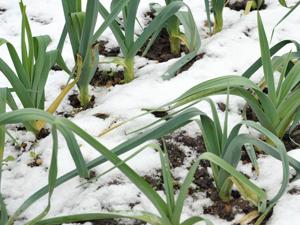Many crops benefit from a light frost
Scotland is cold and harsh. And playful. Mythology likes to have fun, and one old myth says the only animal that can defeat a lion is the unicorn. So, when the English adopted the lion as their mascot, Scotland one-upped them and adopted the unicorn. It worked! The king of Scotland took over the throne of England in 1603. Scotland is a land of more than 900 islands, and in keeping with Scotland's quirky nature, it has the world's shortest commercial passenger flight, from Westray Island to Papa Westray Island. Fasten your seatbelts; the flight lasts exactly two minutes. But Scotland also has a robust cuisine, including the famous soup of leek and peppered chicken stock, cock-a-leekie, often flavored with rice or barley, and prunes.
With approaching winter, you can extend your growing season with greenhouses, cold frames and row covers, or grow vegetables that can handle frosts.
Leeks are one of the vegetables that actually taste better after a light frost. Like many vegetables, leeks developed a built-in antifreeze. Once leeks are hit by frost, they immediately convert some of their starch into sugar. Increased sugars cut down on ice formation in plant cells and can protect the cell membrane from freezing.
So wise gardeners leave leeks in the ground over the winter. You may want to cover them with a mulch of straw so the ground doesn't freeze solid. Your garden now becomes its own cold storage.
Along with leeks, there are other crops that benefit from a light frost. Carrots, parsnips, kale, cabbages, Brussels sprouts, turnips, rutabagas and beets all get sweeter after a frost.
Because your frosted vegetables contain more natural sugar, you will need less sweetener while cooking.
Some of these sweetened crops will surprise you. The lowly beet, once sweetened by frost, can be surprisingly sweet, delicious enough to bake into beet brownies.
Most of these vegetables are best when drizzled with olive oil and roasted.
Cabbage, even if the outer leaves are killed by frost, will be perfectly edible throughout a mild winter.
Turnips ("swedes") and rutabagas ("neeps") are also members of the cabbage family, and not only will their roots be sweeter after a few frosts, but their leaves are also sweet enough to eat.
One root crop that does not benefit from a frost is potatoes.
Even though potatoes convert some of their starch to sugar after a frost, it destroys the flavor.
The frost also turns the potatoes into an unappetizing dark brown when cooked.
So, don't rush to pull up your root vegetables or cabbages before frost hits. The icy chill will trigger these plants to convert starch to sugar. Wait until a few hard cold blasts have hit the garden, and then begin pulling up sweet carrots and parsnips, and of course, leeks. On a cold winter day, simmer up some cock-a-leekie soup and have a feast fit for the king of England, or a unicorn.























































